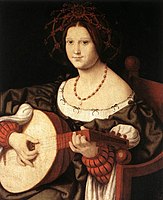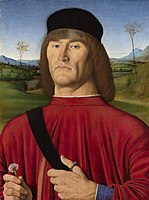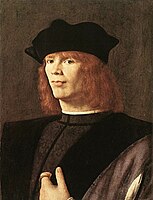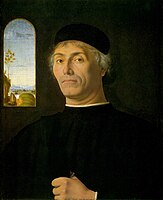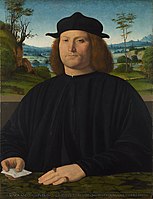Andrea Solari
| Andrea Solari | |
|---|---|
| Narození | 1460 Milán |
| Úmrtí | 1524 (ve věku 63–64 let) Milán |
| Povolání | malíř a výtvarník |
| Příbuzní | Pietro Antonio Solari a Cristoforo Solari[1] (sourozenci) Georges d'Amboise (strýc)[2] |
| Významná díla | Christ Carrying the Cross Crucifixion The Head of Saint John the Baptist on a Charger |
| Některá data mohou pocházet z datové položky. Chybí svobodný obrázek. | |
Andrea Solari (také Solario; 1460 - 1524) byl italský renesanční malíř milánské školy. Označoval se také Andre del Gobbo a Andrea del Bartolo[3] (druhé jméno ovšem sdílel s dalšími dvěma italskými malíři: malířem 14. století ze Sienny Andreou di Bartolo a florentský malířem 15. století Andreou di Bartolo).
Solariho obrazy lze vidět v Benátkách, Miláně, Louvru a na zámku Château de Gaillon v Normandii. Jedním z jeho známých obrazů je Panna Maria se zeleným polštářem (asi 1507) ve sbírkách Louvru.[3]
Galerie
- Marie Magdaléna, asi 1524, Baltimore, Walters Art Museum
- Panna Maria se zeleným polštářem, 1507-10, olej na dřevě (topol), výška 59,5 cm; š. 47,5 cm, Musée du Louvre
- Charles d'Amboise, c. 1507 - olej na plátně; H. 75 cm, W. 52 cm, Louvre
- Kristus na kříži, 1503 - olej na dřevě; H. 111,5 cm, W. 77 cm, Louvre
- Žena hrající na loutnu, c. 1510 - olej na plátně; H. 62,6 cm, š. 49,5 cm, Národní galerie starého umění
- Muž s růžovým karafiátem, c. 1495 - Olejová a vaječná tempera na topolu; H. 50 cm, W. 39 cm, Národní galerie v Londýně
- Portrét muže, c. 1500 - olej na panelu; H.42 cm, W. 32 cm, Galerie Brera
- Portrét mladého muže, po roce 1490 - olej na panelu; H. 31 cm, W. 28 cm, Muzeum Thyssen-Bornemiszů
- Portrét muže, c. 1497 - Olej na dřevě; H. 48 cm, W. 38 cm, Museum of Fine Arts, Boston
- Portrét Giovanniho Cristofora Longoniho, 1505 - olej na desce; H. 79 cm, W. 60,5 cm, Národní galerie v Londýně
- Kristus nesoucí kříž, 1513, olej na desce, 45,5 x 34 cm, Nantes, Musée d'Arts de Nantes
- Portrét vousatého muže, 1500-1510 - černá, červená a žlutá křída na nahnědlém papíře; H. 374 mm, W. 273 mm, Metropolitní muzeum
- Odpočinek na útěku do Egypta, 1515 - olej na descel; H. 77 cm, W. 55 cm, Milán, Museo Poldi Pezzoli
- Salome s hlavou sv. Jana Křtitele, 1506-7 - olej na desce; H. 57 cm, W. 47 cm, Metropolitní muzeum umění
Reference
V tomto článku byl použit překlad textu z článku Andrea Solari na anglické Wikipedii.
- ↑ Dostupné online.
- ↑ Dostupné online.
- ↑ a b Archivovaná kopie [online]. [cit. 2021-01-02]. Dostupné v archivu pořízeném dne 2011-06-15.
Externí odkazy
 Obrázky, zvuky či videa k tématu Andrea Solari na Wikimedia Commons
Obrázky, zvuky či videa k tématu Andrea Solari na Wikimedia Commons
Média použitá na této stránce
Le Christ portant sa Croix, 1513, huile sur panneau, 45,5 x 34 cm, Nantes, musée des Beaux-arts
The artist belongs to the generation bridging the 15th and 16th centuries and was highly regarded in his own day for his portraiture. This early portrait was executed during the artist's stay in Venice, the sitter, who holds a pink or carnation in his right hand indicating a betrothal portrait, was probably a Venetian senator.
"A man carries a pink, or carnation, in his right hand. It was the custom for a bride to hide a pink in her clothes on her wedding day. Its presence here, along with the large blue and gold ring on the man’s left thumb, suggests that the portrait commemorates his marriage.
Solario was from Milan though he also worked in Venice. Although the man’s identity is unknown, his outfit tells us he was a Venetian of high rank. The cap and stole – the piece of fabric folded across his chest – signified maturity in Venice. His tunic suggests he may have been a magistrate, as only members of one of the city’s councils were permitted to wear red.
Venice in the 1490s was at the centre of innovations in portraiture thanks to the adoption of new techniques and ideas from contemporary Netherlandish painting. Solario has painted the man in the latest fashion using a three-quarter, rather than profile, pose set against the background of a green valley." [1]



